
Starting Web App in 2023 Research Results
Introduction
Last year, we conducted a groundbreaking study on how web apps were started in 2022, which received a lot of attention and numerous citations. This year, we're excited to have continued that research to capture the latest trends and dynamics in the web app development industry.
Our goal was to understand how web apps are started in 2023, regardless of the job title of those launching web app projects. This allows us to capture trends in both low-code/no-code (LCNC) and traditional approaches, specifically, the percentage of those, who choose the LCNC approach over the classical one.
Below you will find more insights into the technologies, frameworks, tools, platforms, and specific patterns that engineers will follow to launch web applications in 2023.
The survey was conducted between April and June 2023. 303 respondents from 33 countries participated.
Key outcomes
The key findings of the study, grouped by category, are presented in this section:
Building web applications
-
Number of users who prefer a combination of LCNC and classical approach to start web applications grew significantly (from 22.3% last year to 32.7% this year) (LCNC gain popularity BUT only with a combination of classical approach)
-
Low-code/now-code tools remain popular among entry-level engineers. The less experienced the engineer, the more they prefer to use no-code/low-code solutions to create web applications.
-
The majority of engineers, regardless of experience level, would use starter kits or boilerplates for web development.
-
Experienced engineers are more likely to pay for 3rd party code (e.g. template, starter kit).
-
WordPress and Wix are the most commonly used no-code/low-code solutions, while in the previous year, these were Retool and Bubble, though the market is very fragmented and differences are low.
Technology
- React, Node.js, and PostgreSQL are the most in-demand web development technologies.
-
The most popular technology stacks for 2023 are React and Node.js. Vue and Angular are a close second as front-end technology stacks, with Python and PHP coming in second and third as back-end technology stacks.
-
AWS is the most preferred cloud hosting platform for web applications.
-
Although headless CMS and serverless solutions are gaining traction, most developers still prefer to manage databases themselves.
-
Predominantly, engineers avoid using code generation tools.
-
GitHub is the leading code hosting platform.
-
Bootstrap is the most used library for styling and components, followed by Tailwind CSS. Compared to last year, Tailwind CSS has swapped places with Material UI.
Learning to code
-
Most respondents prefer to learn code from online resources, especially through online videos.
-
There is also a direct correlation between engineers' experience and their source of learning code. Respondents with less experience are more likely to use online courses, forums, and other online resources to learn code. Engineers with more experience, on the other hand, tend to learn code through more traditional methods such as school and reading.
Usage of AI tools
-
50% of respondents indicated they are going to use AI tools to start web apps.
-
Respondents with less web development experience are more likely to choose AI tools for web application development, while those with more experience showed mixed results.
Third-party tools
- Most respondents would invest in expensive third-party code or SaaS tools if it meant faster development.
- More experienced respondents will typically pay more, but will usually opt for a one-time purchase.
Methodology
The survey included 21 anonymous questions about web development and was completed by 303 participants from 33 countries. With a statistical significance of 90% and a margin of error of 5%, the survey was conducted from April 10 to June 20, 2023. No specific type of web application was specified deliberately to allow for a wide range of responses and to capture whatever one means when referring to “web application”. The audience was primarily drawn from Flatlogic's digital platforms such as onsite messaging, blog posts, email lists, banner ads, and social media posts. Other engineers from the web development community were also asked to help complete the survey via paid advertising.
All questions were required to be completed, and some questions were unspecified, leaving open-ended options for participants to share their perspectives.
If you would like to see the original questionnaire, please use the URL provided. Note, however, that the form of the questions is no longer applicable and should not be filled out.
Engineer profile
Here is what we know about the profile of participants.
Experience
The results of the survey show that the majority of respondents had at least one year of software development experience. In addition, many respondents had more than 10 years of software development experience.

Geography
In total, developers from 33 countries participated in the study.
Starting web application
How engineers build web applications
Although low-code/now-code tools are gaining popularity, the majority of respondents (56.6%) still prefer to build web applications by writing code, but that number has decreased by 10% since 2022. A slightly smaller number (32.7%) said they would use a combination of code and low-code/now-code tools. The number of respondents who would use a combination of code and low-code/now-code tools increased significantly by 10% year-over-year, while only 5% would use only LCNC tools.
5.4% said they would use professional services. This is not significantly different from last year.
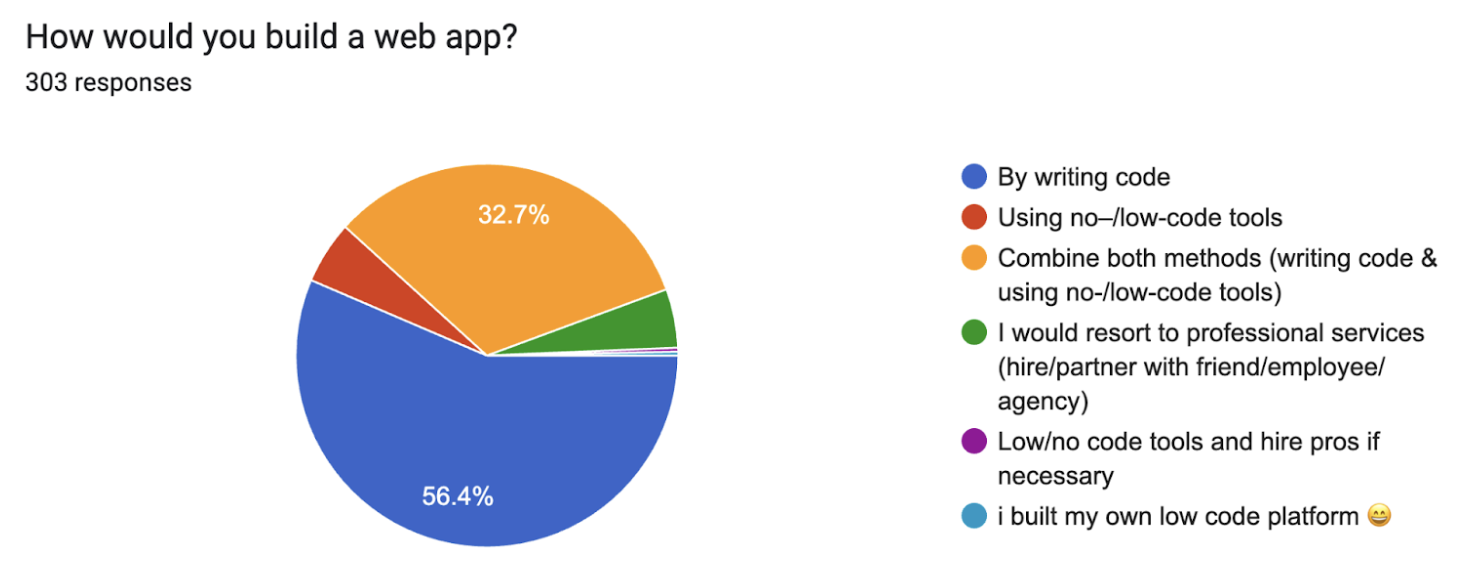
As the comparison between 2022 and 2023 data shows, the combination of low-code/no-code (LCNC) tools with traditional web application development approaches has grown significantly in popularity. The number of users favoring this combination has increased - from 22.3% last year to 32.7% this year.

Although entry-level developers are more likely to choose low-code/now-code tools (with only 56% preferring to write code), only 6% with more than 10 years of experience prefer these tools.
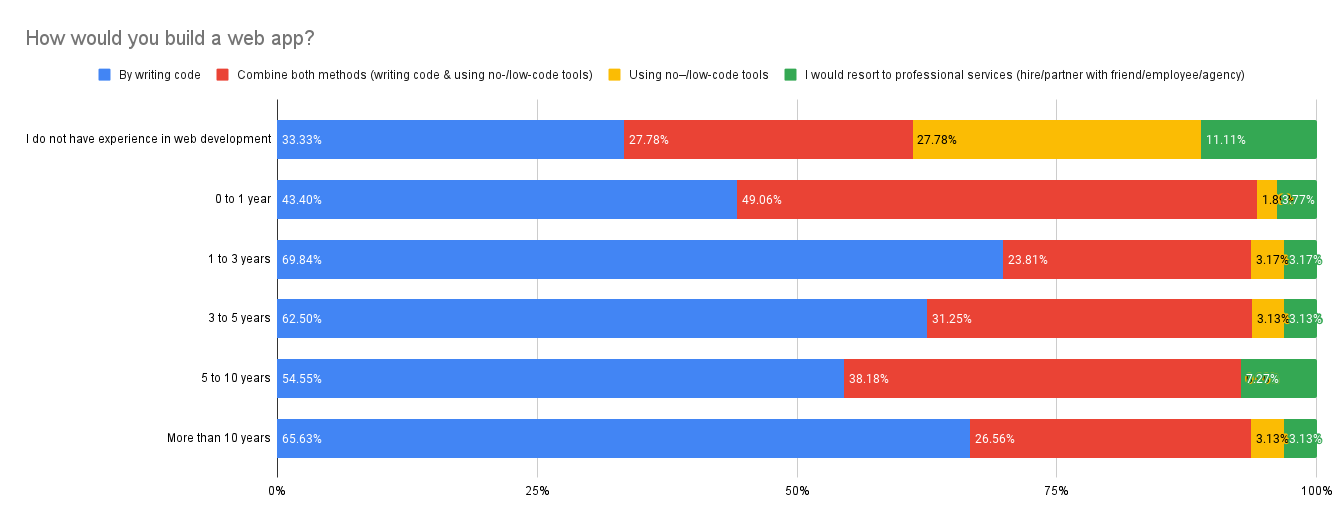
The conclusion is that the more experienced web developers are, the more likely they are to prefer writing code (the old-school way) rather than using low-/no-code tools. low-code/no-code tools are more popular with entry-level developers. However, this is changing to more mixed approaches: more developers prefer to use some sort of combination of LCNC & classical development, which gains the advantages of no code but keeps the flexibility of classical development.

The vast majority of engineers - 89.8% - would use starter kits/boilerplates and other templates to build a Web Application. But only 11.2% would use paid solutions.
| How many years of experience in web development (programming) do you have? | Yes, I would use free one (e.g. from GitHub) | No, I would not use a template | Yes, I would use paid one (e.g. from Themeforest) |
|---|---|---|---|
| I do not have experience in web development | 63.89% | 25.00% | 11.11% |
| 0 to 1 year | 64.15% | 32.08% | 3.77% |
| 1 to 3 years | 58.73% | 36.51% | 4.76% |
| 3 to 5 years | 53.13% | 37.50% | 9.38% |
| 5 to 10 years | 54.55% | 25.45% | 20.00% |
| More than 10 years | 54.69% | 32.81% | 12.50% |
Surprisingly, engineers with 1 to 3 years of experience are the least likely to use templates. It can be speculated that at this early stage, these engineers are gaining their first hands-on experience and developing a sense of confidence in their abilities. As a result, they may be less likely to rely on pre-existing templates or someone else's code, preferring to build from scratch.
Conversely, more experienced engineers with solid backgrounds are more likely to use templates to speed up the development process. As they gain knowledge and expertise over time, these engineers recognize the value of using templates as a means to increase productivity and efficiency.
No-code/low-code tools
The LCNC tool market is fragmented with no clear leader, although the most popular low-code/now-code tools are WordPress and Wix with a slight edge over FlutterFlow. However, more than 44% of respondents would not use any of the low-code/now-code tools to build web applications.
No-code/low-code market is still a very fragmented one with no clear leader. Flatlogic bias was present in the data due to the data collection mechanism.
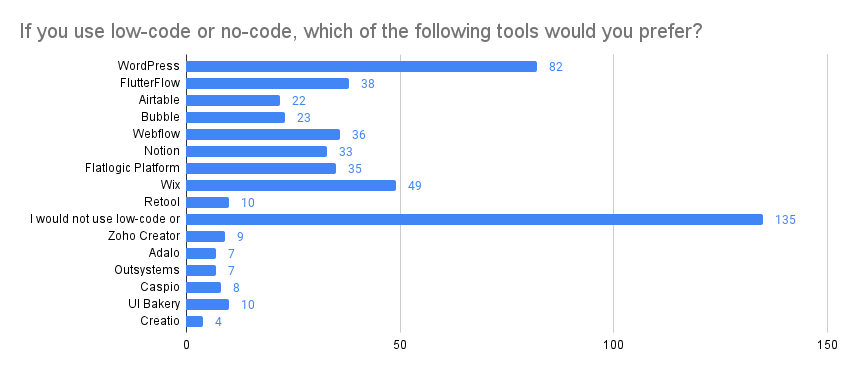

In terms of the distribution of responses by the tool based on an approach to web application development, the following trends can be observed. Developers who prefer to write code from scratch were overwhelmingly opposed to using low-code/now-code tools. However, among those who are open to both methods, WordPress emerged as the most popular tool, likely due to its customizable features.
WordPress has begun to position itself as a no-code tool, but it is not a comprehensive LCNC tool because it requires coding skills and technical knowledge for customization beyond its pre-built templates. While user-friendly, it falls short of advanced customization without coding involvement.
It is worth noting that engineers who would consider hiring professional services also tended to avoid low-code/now-code tools. On the other hand, for the group inclined to use no-code/low-code approaches, WordPress and Wix emerged as the most popular products.

Regarding the preferred approach to building a web application, the majority of respondents, regardless of experience level, favored writing code. However, there was a notable trend among respondents with more experience to choose a combination of writing code and using no-/low-code tools.
In terms of specific no-/low-code tools cited by respondents, WordPress emerged as a frequently cited choice across experience levels. Wix was another popular option mentioned by many respondents. FlutterFlow was mentioned by a few respondents with 1 to 3 years of experience, which is a sign of bias in our data, mostly collected from Flatlogic sources. In addition, Webflow was mentioned by several respondents, including those with 5 to 10 years of experience.
Preferences in low-code/now-code tools, depending on experience, are as follows.
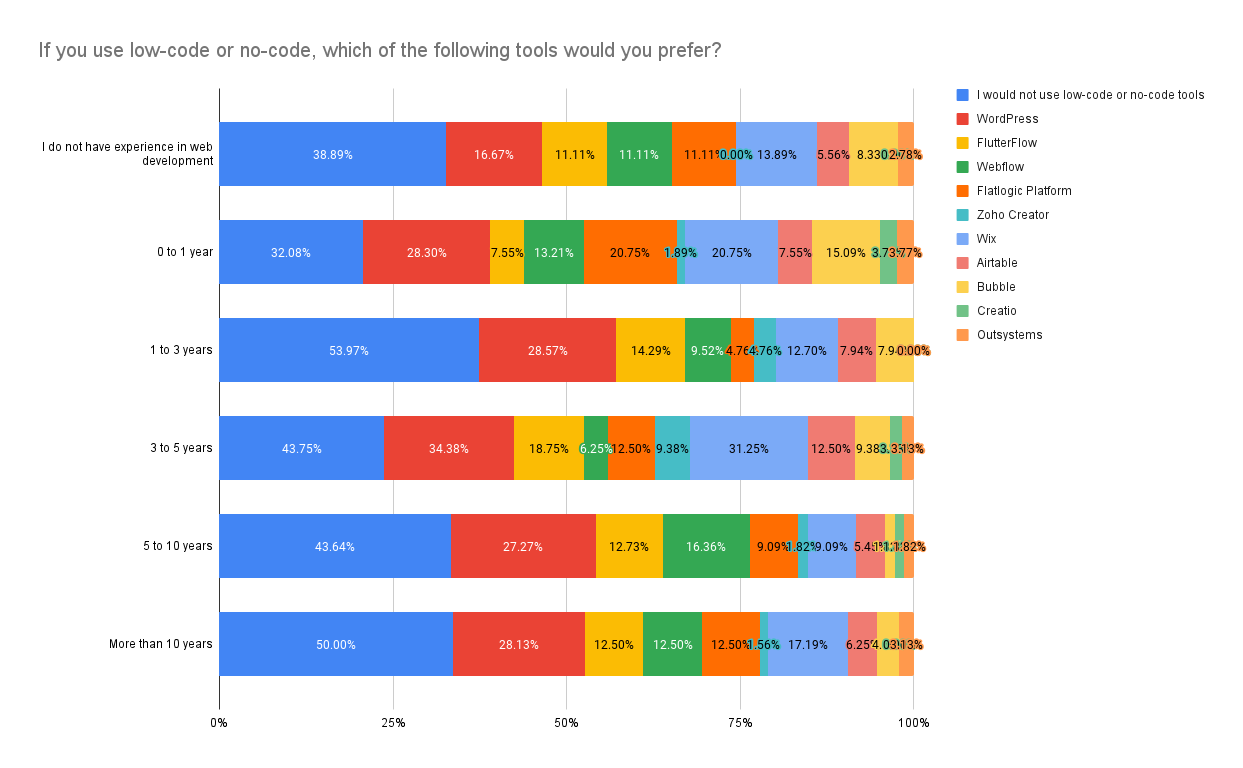
Learning how to code
Not surprisingly, more than half of respondents chose to learn Web development online. Resources such as online classes, forums, and other digital materials are popular among younger respondents. Conversely, older respondents tended to prefer more traditional methods of learning, such as attending school and reading books. Interestingly, some respondents mentioned gaining knowledge through programming as an additional source of learning.
Compared to last year, there is a clear trend that video content is replacing everything! The choice of video as a source of learning has increased from 3% to 21.8%.

We also analyzed the relationship between how people learn and their level of experience.

Technologies and Frameworks
The goal of this section was to find out what technological tools engineers choose and use when building Web applications.
Web development technologies overall
In the first inquiry, we asked participants to select from up to 70 available options of the web development technologies, frameworks, libraries, and tools that they either use or plan to use. We assumed that people would immediately select the technologies that were most familiar and comfortable to them. The results returned showed that the most popular choices among respondents were Javascript, HTML5, and CSS3.

Frontend technologies
React is predicted to be the undisputed leader among front-end frameworks. Vue and Angular are a close second.

The popularity of technologies depends on work experience. Developers with less experience (0-3 years) often gravitate toward frameworks like Angular and React, which have robust communities and extensive documentation. These frameworks provide a solid foundation and offer a wide range of resources for beginners to learn and build upon.
As developers gain more experience (3-5 years), they can explore alternative frameworks such as Ember or Vue. These frameworks have their unique advantages and cater to specific development styles or preferences.
However, it's important to note that experience alone does not dictate the choice of front-end stack. Project requirements, team collaboration, industry trends, personal preferences, and other factors also play an important role. Developers often adapt and learn new frameworks based on the needs of the project or to expand their skill set. But still, React remains a clear leader in all experience groups.
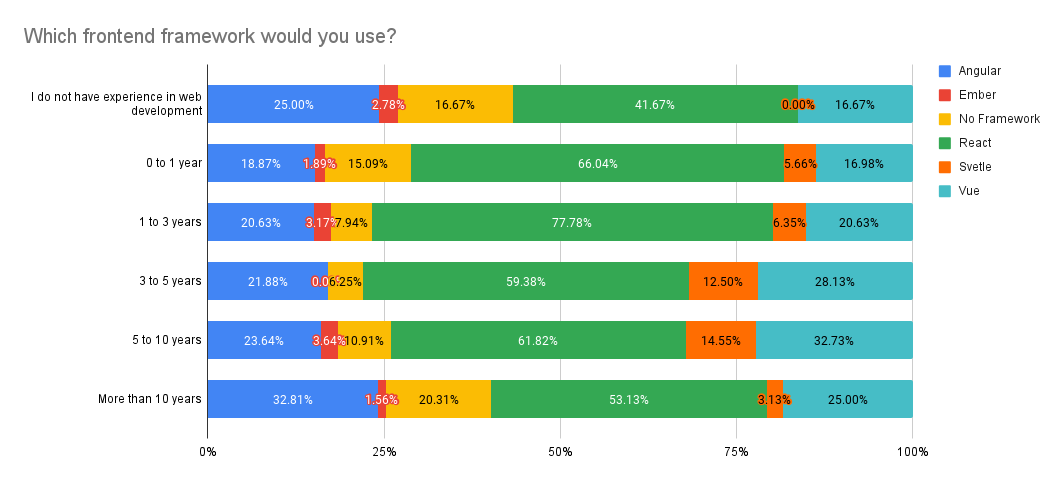
Back-end technologies
Node.js is by far the most prominent back-end technology, with Python and PHP coming in second and third, respectively. This result is consistent with the results of many other surveys, suggesting that it is typical.
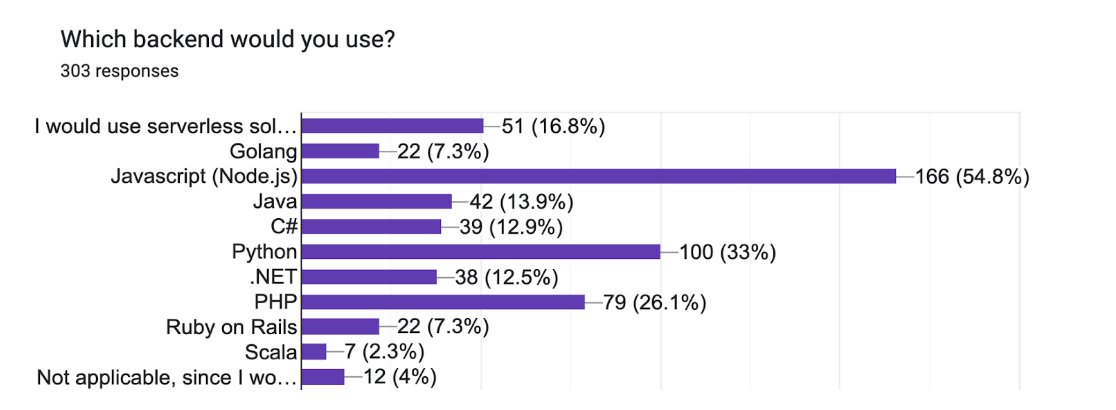
Respondents with 1-3 years of experience are more likely to choose popular and versatile options such as JavaScript (Node.js), Java, and PHP. These stacks are known for their ease of use and the wide range of libraries and frameworks available.
As developers gain more experience (3-5 years and 5-10 years), their choices become more diverse. Some continue to use the above stacks, while others explore emerging technologies such as serverless architectures (Jamstack, Firebase) or dive into specific languages such as Golang or .NET. Java & javascript are clear leaders.
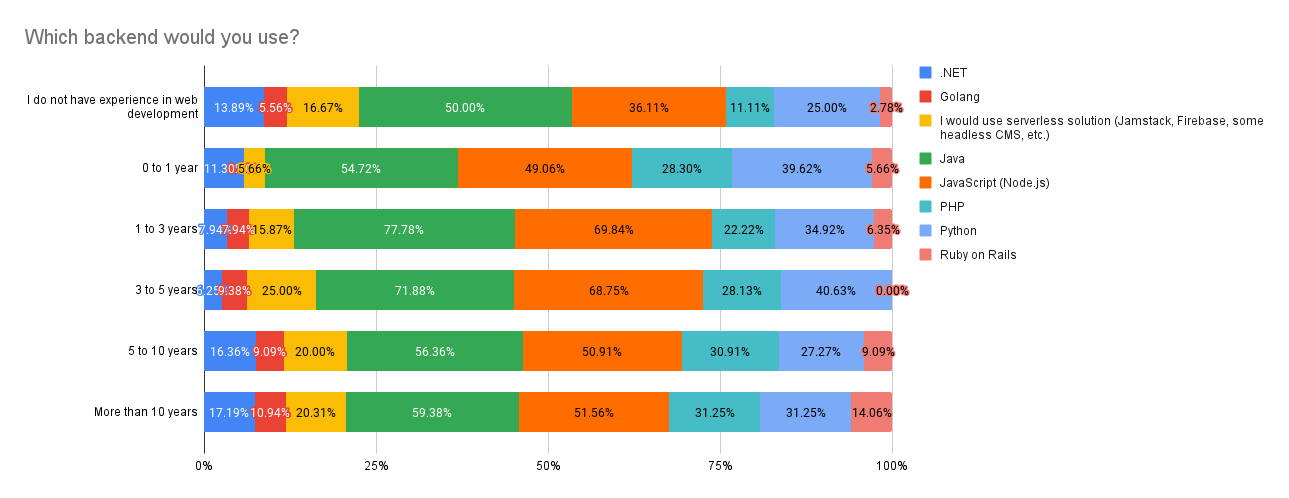
Data management
Now let's look at data storage and management. Most developers opt for self-managed databases, although the use of headless CMSs and serverless solutions is growing since last year, from 3% to 11.6%. In the mainstream, there's a small number of people leaning towards Firebase and Azure MySQL.

What's more, there is no clear connection between experience and data management methods. Despite varying levels of experience, the majority of engineers chose to personally control the associated database.
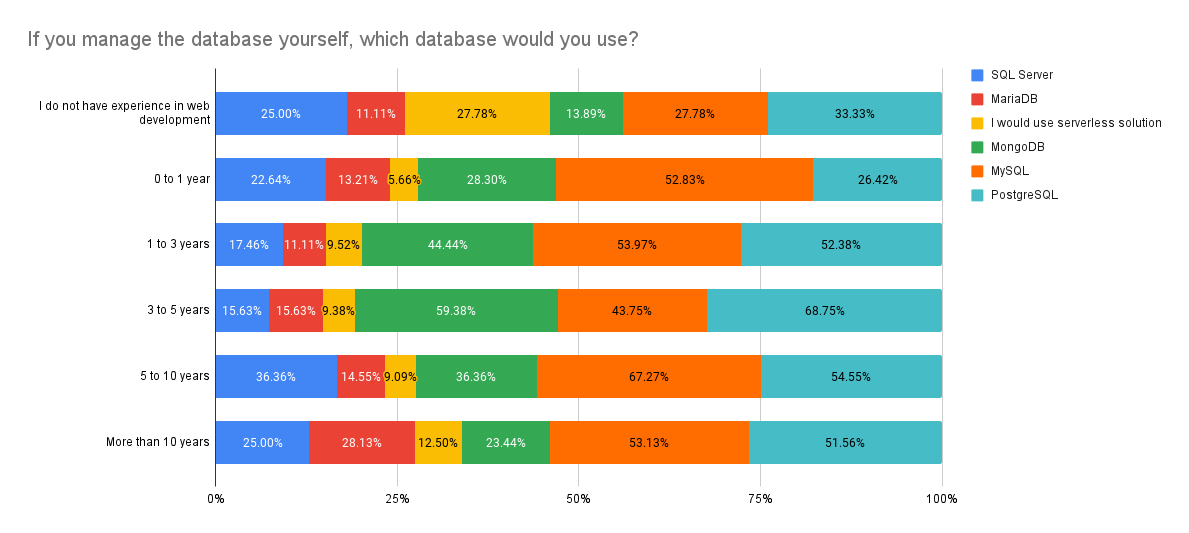
Relational databases are the most popular choice among Web developers of all experience levels. Interestingly, more experienced developers choose MySQL over PostgreSQL. MongoDB is less popular among experienced engineers, although it is quite fashionable.

Relationship between Front-end, Back-end, and Data management solutions
We also see a correlation in the choice of front-end and back-end technologies. The engineers who use React are more likely to choose node.js as their back-end solution. Vue engineers also prefer PHP and Angular loves the .NET back-end. But overall, node.js is the most preferred choice.
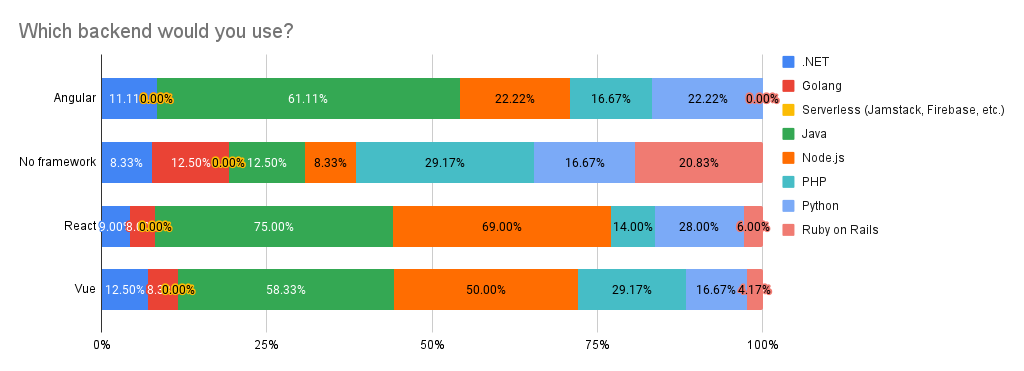
In addition, we can see that Node.js development teams use each of the major DBs almost equally. PHP users rely on MySQL due to its standardization within the PHP web development domain.
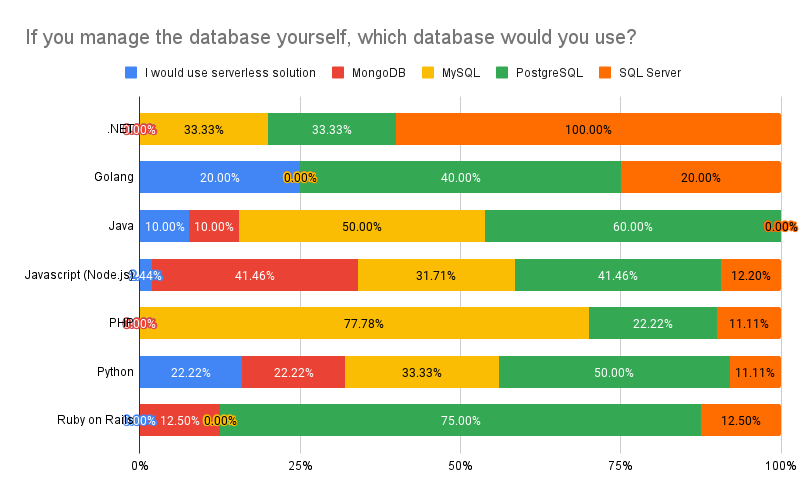
We reviewed the industry's traditional conventions about technology adoption in this part of the assessment..
Hosting and deployment
As far as hosting is concerned, there were no surprises. Amazon AWS is the leader. Moreover, it is in line with other surveys on the market.

Code-generation tools
More than 70% of respondents do not take advantage of code-generation tools such as Yeoman, Rails Scaffolder, and similar ones.
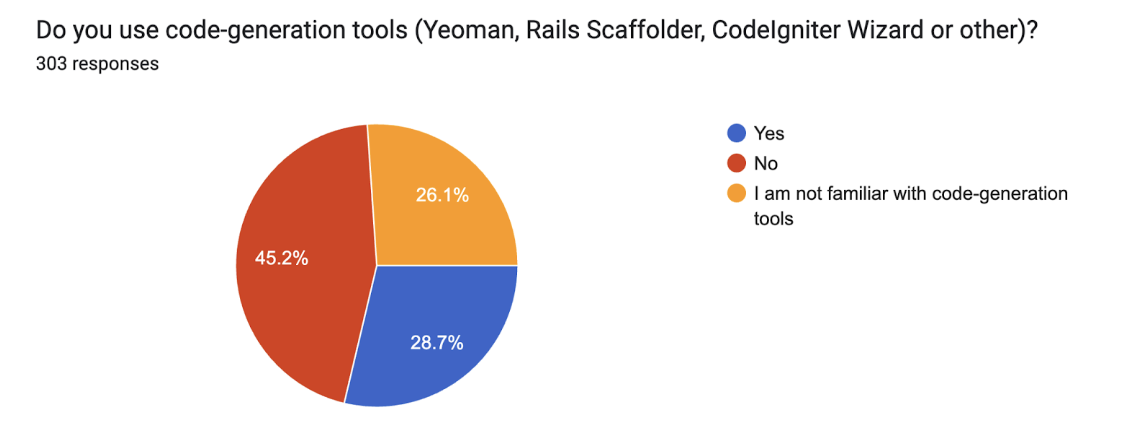
Experience does not seem to significantly impact one's preference for using code-generation tools. Nonetheless, engineers having 10+ years of experience tend to depend more on scaffolding tools.
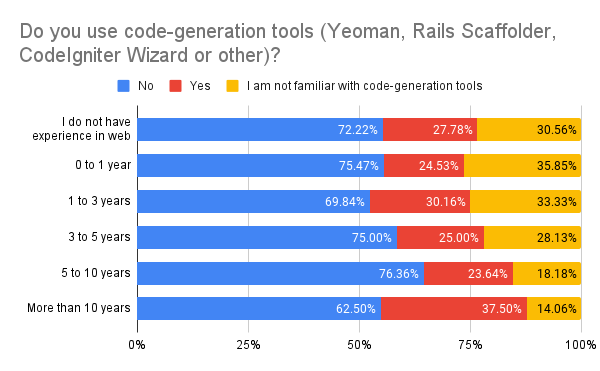
Code management tools
Most developers see GitHub as the go-to option for hosting and managing their code, with a few individuals selecting in-house servers instead.

API
More than 77.9% of engineers prefer REST APIs when setting up web applications, leaving only 8.6% of respondents who did not select this option.

CSS and components libraries
Bootstrap remains the overwhelming favorite for CSS/component libraries, followed by Tailwind CSS and Material-UI respectively. Compared to last year, Tailwind CSS has swapped places with Material UI.
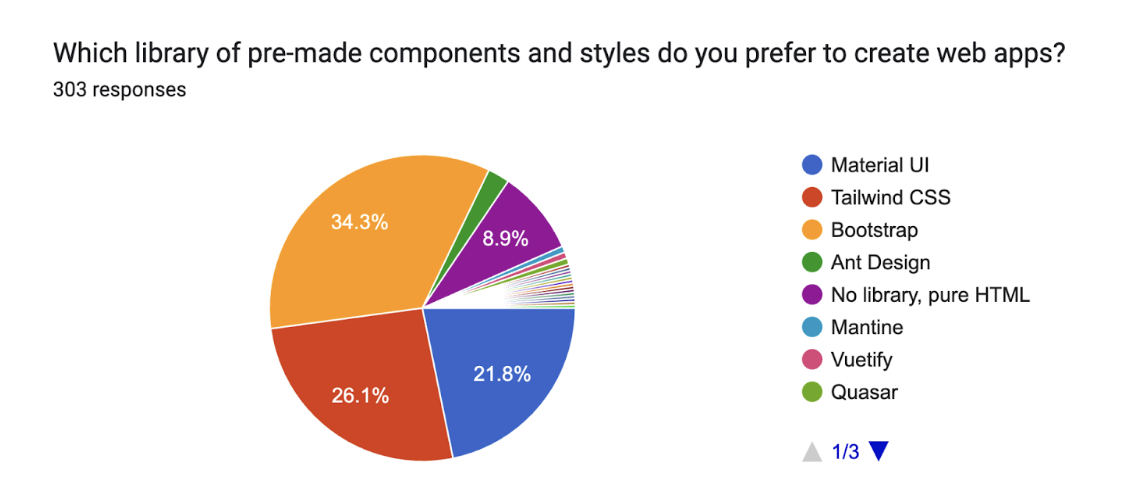
Purchasing third-party code
The following section focused on third-party code pricing and purchasing.
Purchasing third-party code
Most Web developers would choose to purchase pre-built code if it would speed up the creation process.
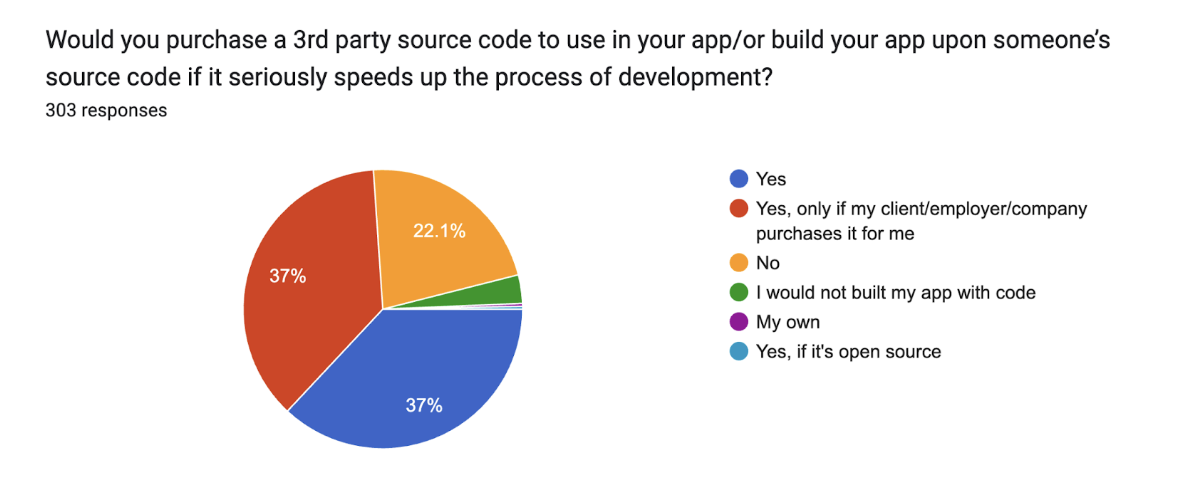
Respondents with 1-10 years of experience are more likely to purchase ready-made code to develop Web applications.
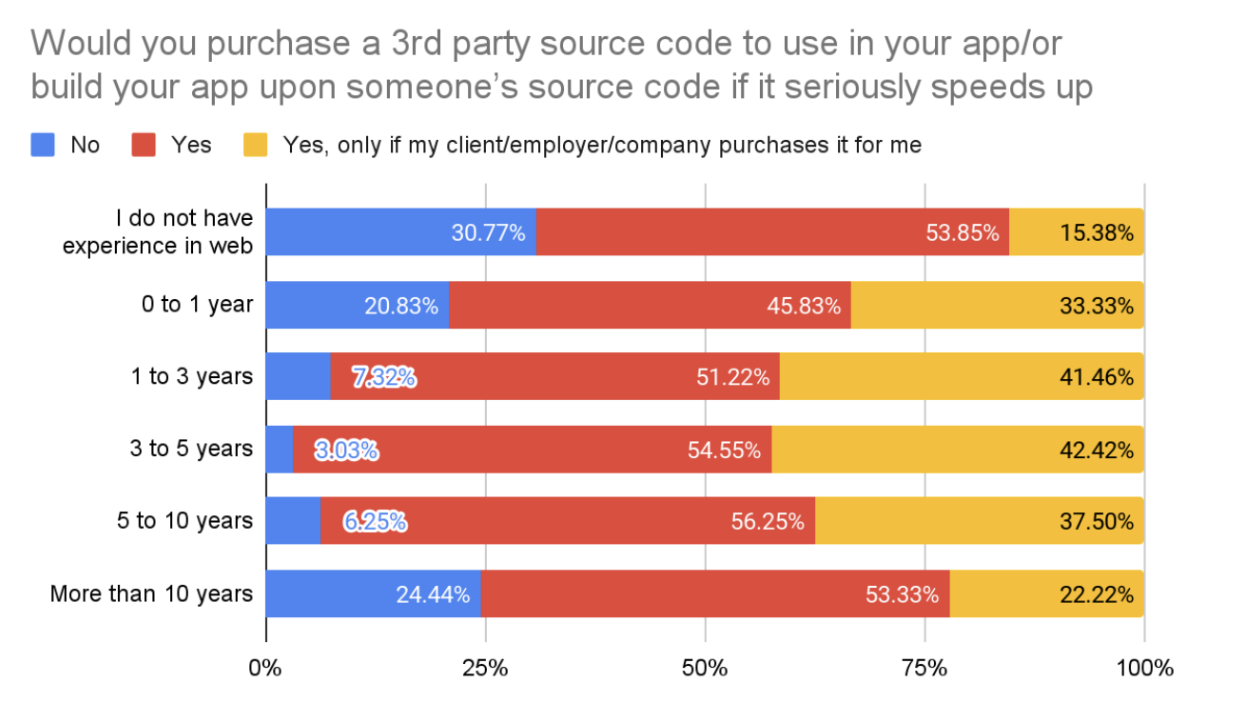
Spending on third-party code
Responses to the amount you would pay for pre-built code correlated with the cost options. The more economical the price, the more responses there were for that option. Regardless, the first 3 choices had similar numbers of responses.
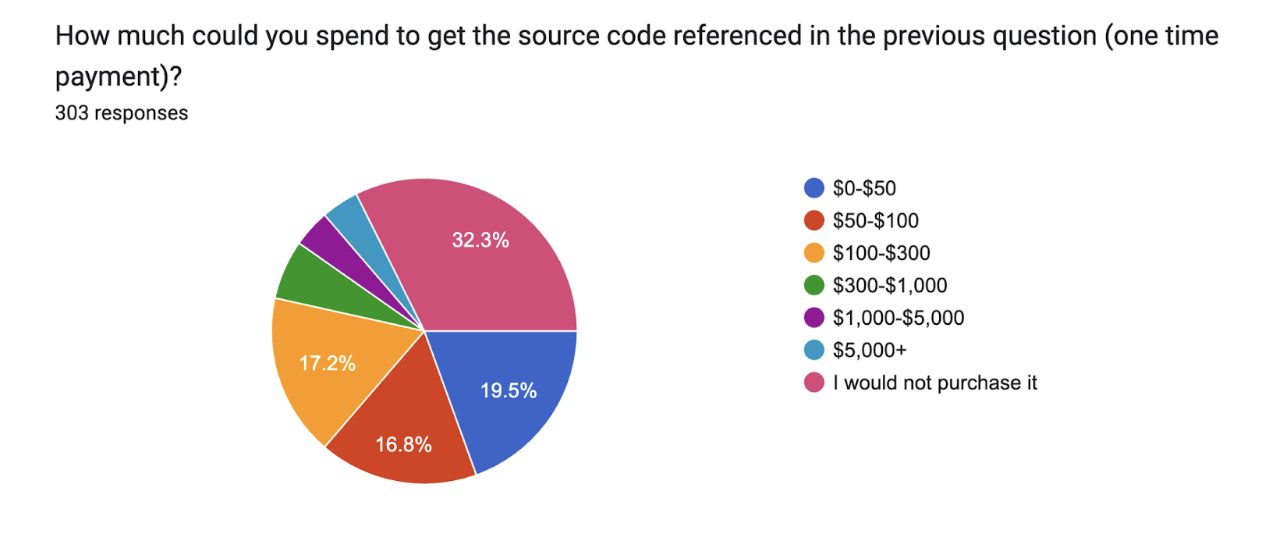
Experienced developers can spend more to purchase third-party code. We believe this is because they understand the true value of the code. They are also more likely to make a purchase regardless of price.

Spending on SaaS tools for web development
Developers spend more on one-time purchases than on SaaS tools.
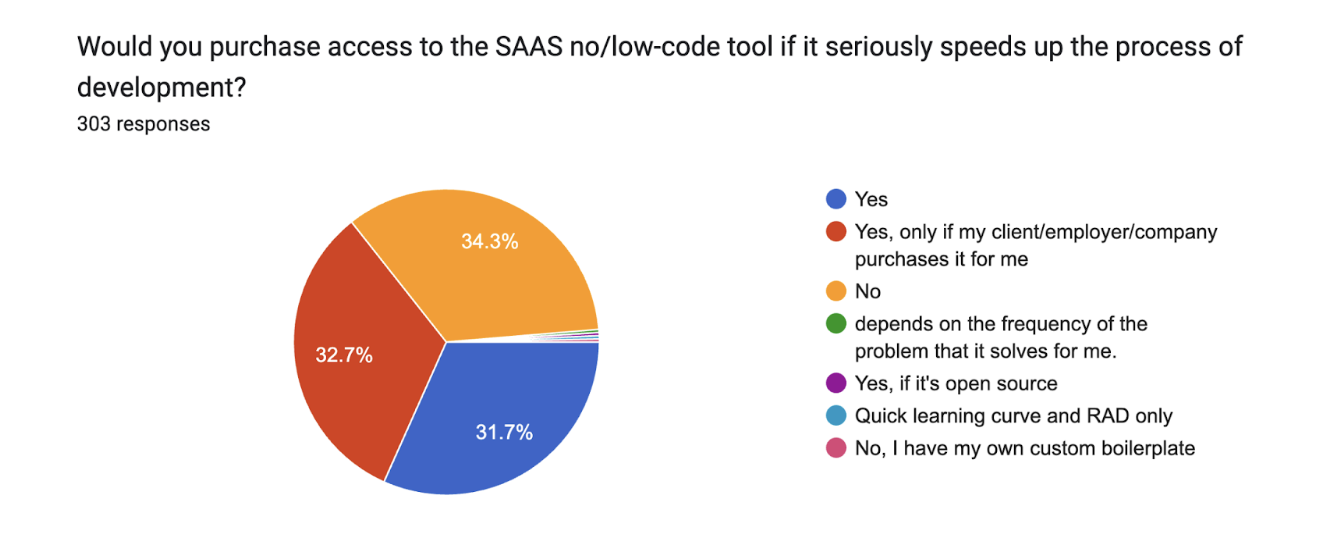
Experienced developers are typically reluctant to spend as much money on SaaS solutions as their less experienced counterparts.
Overall, developers are less likely to subscribe to tools than to one-time purchases of pre-built code. Nearly 34% of respondents would rather not pay for SaaS tools, while 32% would rather not pay a one-time fee for pre-built code. In addition, engineers are reluctant to invest large sums of money in SaaS tools, even if they are willing to invest in them.
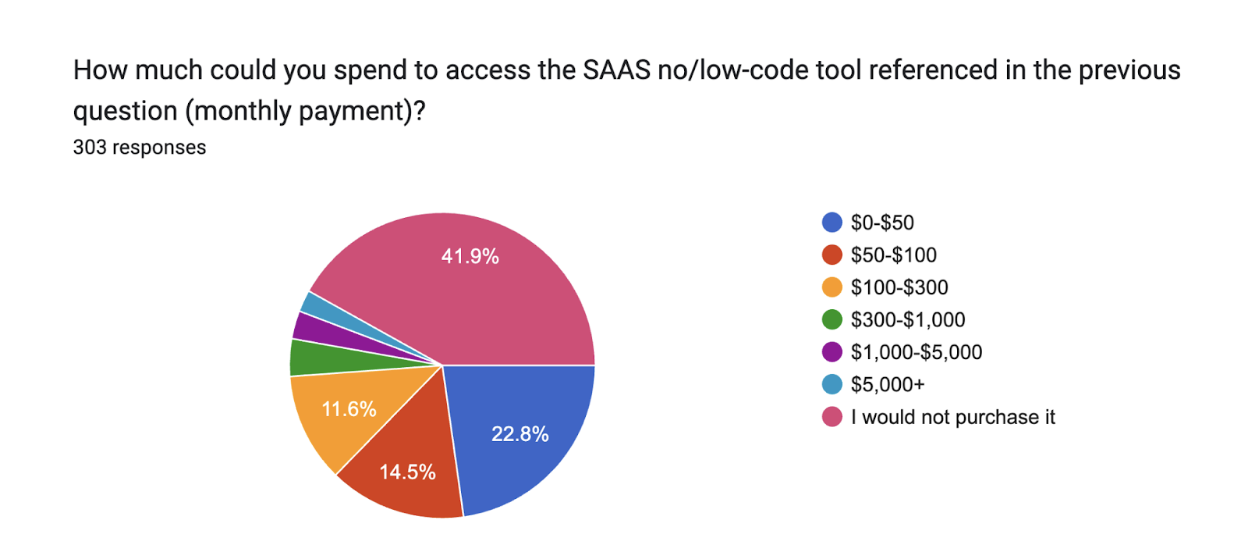
Respondents in the 0 to 1-year bracket, as well as those in the 5 to 10-year bracket, share an aversion to spending money on Software-as-a-Service (SaaS) tools.

Using AI tools
Finally, the most curious question about AI that we added this year revealed that by 2023, nearly 50 percent of engineers will use AI tools in the process of building web applications, and 26.5 percent plan to use them.

It can be concluded that respondents with 1 to 3 years of web development experience are most likely to choose AI tools for starting a web application. Respondents who either already use AI tools or plan to use them in the future were more common in this group. On the other hand, individuals with more than 5 years of web development experience had a mixed response, with some using AI tools and others not actively considering or planning to use them.
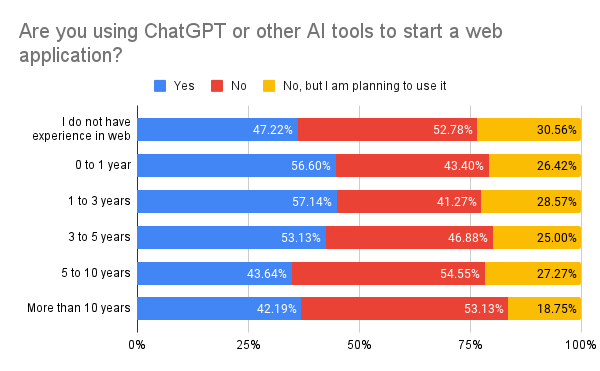
The use of AI tools is widespread among web application developers, regardless of their chosen method for starting development. Whether individuals start by coding from scratch or using LCNC tools, most respondents are using or planning to use AI tools. This suggests that AI technology is playing a significant role in facilitating web application development, potentially increasing efficiency and productivity in the field.
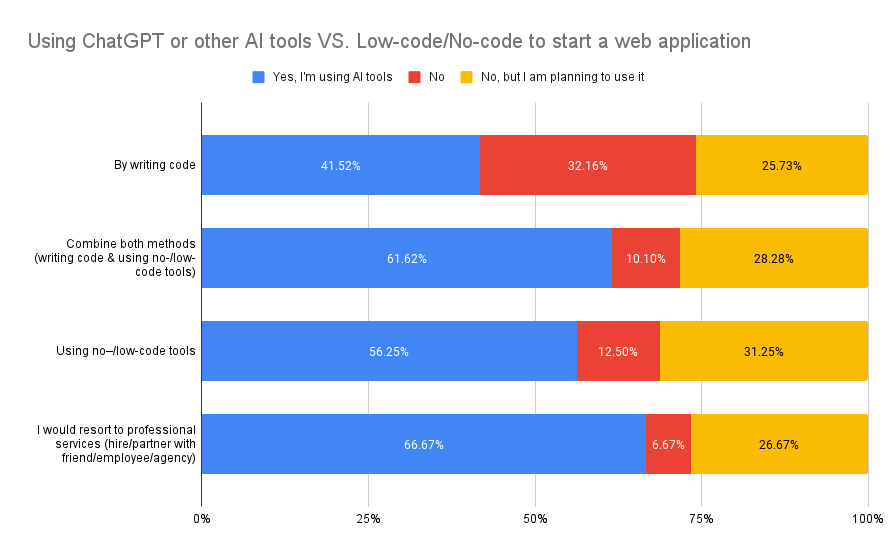
Comparison With The 2022 Study Results
By comparing data from the Starting Web App in the 2023 study to the previous year's study, we can gain insight into potential dynamics and changes in preferences and trends. Let’s take a look at it.
Compared to last year most respondents prefer to learn code from online resources, especially through online videos. There is a clear trend that video content is replacing everything! The choice of video as a source of learning has increased from 3% to 21.8%.
Over the past year, developers' preferences for low-code/now-code tools have shifted. Our results show that the LCNC market is still very fragmented and Wordpress became a leader in this field, probably because Wordpress started to position itself as a no-code tool, while Retool and Bubble which were once the most popular choices, lost their positions. Current trends indicate that WordPress and Wix have now emerged as the preferred no-code solutions in 2023, though it is important to underline that the market is still fragmented, data availability is low and the definition of LCNC is vague. This is likely due to WordPress being mostly a free tool with a large ecosystem of free and paid plugins.
Node.js continues to be the most popular back-end technology among developers, with PHP a close second and Python, which surpassed Java last year, in third place. Engineers with less experience tend to choose Node.js, while more experienced engineers have access to a wider range of technologies.
Of the respondents surveyed in both 2022 and 2023, the majority do not use code-generation tools, and there appears to be no relationship between experience and preference for code-generation tools.
In 2023, Bootstrap was still the most popular CSS/component library among engineers, but Tailwind CSS has exchanged places with Material-UI and became the second most popular CSS library, and Material-UI is now the third most popular.
Conclusion
The main conclusion is that the trend of combining low-code/no-code (LCNC) tools with traditional approaches to web application development has grown significantly in popularity. The number of users favoring this combination has grown significantly, from 22.3% last year to 32.7% this year. However, it is important to note that LCNC tools continue to attract entry-level developers, especially those with limited web development experience. This preference for LCNC solutions among less experienced engineers reflects the convenience and accessibility these tools offer in simplifying the web application development process. As the industry evolves, it will be interesting to see how the synergy between LCNC and traditional approaches shapes the future of web development and whether LCNC tools continue to gain traction among more experienced professionals.
Engineers with limited experience often rely on online sources to gain knowledge, while seasoned software developers prefer traditional methods like books to expand their expertise. Currently, WordPress and Wix lead the no-code/low-code platform space in terms of popularity, though with a very small advantage.
The most popular web application development stack includes React, Node.js, Azure MySQL, Amazon AWS, and Bootstrap, which is consistent with similar findings from industry surveys. Rather than opting for headless CMS or serverless solutions, most engineers prefer to handle database management themselves. Those with more than 5 years of software development experience are more likely to invest in third-party code and SaaS tools if it speeds up the development process.
We plan to conduct an annual study to ensure ongoing evaluation of the results. It remains uncertain whether experienced engineers will continue to embrace low-code/now-code tools, or whether these tools will gain more traction as entry-level engineers progress in their careers.
Just like last year, it appears that "trendy" tools such as low-code/no-code platforms, MongoDB, and GraphQL are primarily fashionable choices. Most engineers, especially those with extensive experience, still tend to use traditional and fundamental alternatives such as writing code, using relational databases, and using REST APIs. However, this assertion needs to be reevaluated every year to assess the evolving dynamics. So far it holds for two years in a row.
And 2023's icing on its cake is that it's all about using and implementing AI tools. Among respondents, those with little web development experience were most likely to choose AI tools for web application development, with a large proportion already using or planning to use them, while respondents with fairly extensive web development experience showed mixed results in using AI tools.
Feel free to leave your comments on our social media pages (Twitter, Facebook, Linkedin) if you have any suggestions, questions, or criticisms! We are open to discussion and feedback.
If you need raw data - please contact us at [email protected], we will be happy to share!